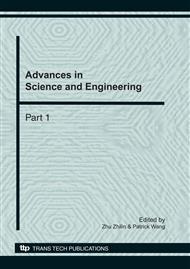[1]
V. Setlur, S. Takagi, R. Raskar, M. Gleicher and B. Gooch. Automatic image retargeting. In Proc of Mobile and Ubiquitous Multimedia (MUM), 59-68. (2005).
DOI: 10.1145/1149488.1149499
Google Scholar
[2]
B. Suh, H. Ling, B. Bederson and D. Jaobs. Automatic thumbnail cropping and it's effectivness. In ACM Conference on User Interface and Software Technolgy, 95-104. (2003).
DOI: 10.1145/964696.964707
Google Scholar
[3]
A. Santella, M. Agrawala, D. Decarlo, D. H. Salesin and M. F. Cohen. Gaze-based interaction for semi-automatic photo cropping. In ACM Human Factors in Computing Systems (CHI), 771-780. (2006).
DOI: 10.1145/1124772.1124886
Google Scholar
[4]
J. Wang and M. Cohen. Simultaneous matting and compositing. ACM Siggraph Technical Sketch, (2006).
Google Scholar
[5]
Y. S. Wang, C. L. Tai, O. Sorkine and T. Y. Lee. Optimized scale-and-stretch for image resizing. ACM Transactions on Graphics, (2008).
DOI: 10.1145/1409060.1409071
Google Scholar
[6]
L. Itti and C. Koch. A saliency-based search mechanism for overt and covert shifts of visual attention. Vision Research, 1489-l506. (2000).
DOI: 10.1016/s0042-6989(99)00163-7
Google Scholar
[7]
L. Ligang, C. Renjie, W. Lior and M Cohen. Optimizing Photo Composition. Computer Graphic Forum (Proceedings of Eurographics), 469-478. (2010).
Google Scholar
[8]
L. Itti and C. Koch. Feature combination strategies for saliency-based visual attention systems. Electron, Imaging, 1-9. (2001).
DOI: 10.1117/1.1333677
Google Scholar
[9]
O. L. Meur, P. L. Callet, D. Barba and D. Thoreau. A coherent computational approach to model bottom-up visual attention. IEEE Trans, On Pattern Analysis and Machine Intelligence. 802-817. (2006).
DOI: 10.1109/tpami.2006.86
Google Scholar
[10]
P. J. Burt and E. H. Adelson. The laplacian pyramid as a compact image code. IEEE Trans Commun, 32-40. (1983).
DOI: 10.1109/tcom.1983.1095851
Google Scholar
[11]
D. M. Weber and D. P. Casasent. Quadratic gabor filters for object detection. IEEE Transactions on Image Processing, 218-230. (2001).
DOI: 10.1109/83.902287
Google Scholar
[12]
J. K. Tsotsos, S. M. Culhane, W. Y. K. Wai, Y. H. Lai, N. Davis and F. Nuflo. Modelling visual attention via selective tuning. Artificial Intelligence. 507-545. (1995).
DOI: 10.1016/0004-3702(95)00025-9
Google Scholar
[13]
S. Lok, S. Feiner and G. Ngai. Evaluation of visual balance for automated layout. Intelligent User Interfaces, 1-8. (2004).
DOI: 10.1145/964442.964462
Google Scholar
[14]
Z. Byers, M. Dixon, W. D. Smart and C. Grimm. Say cheese! experiences with a robot imagegrapher. AIMagazine. 37-46. (2004).
Google Scholar
[15]
B. Gooch, E. Reinhard, C. Moulding and P. Shirley. Artistic composition for image creation. In Proc of the 12th Eurographics workshop on Rendering Technique, 83-88. (2001).
DOI: 10.1007/978-3-7091-6242-2_8
Google Scholar


